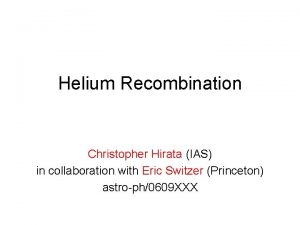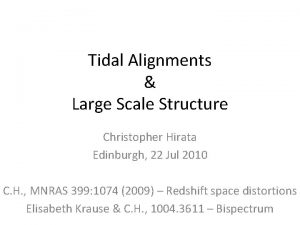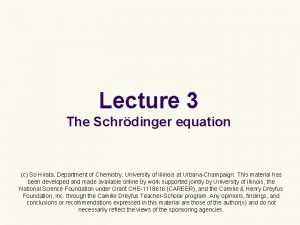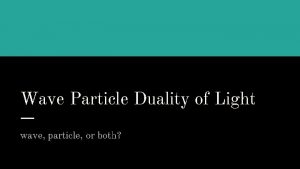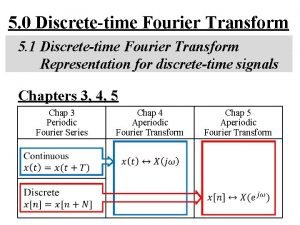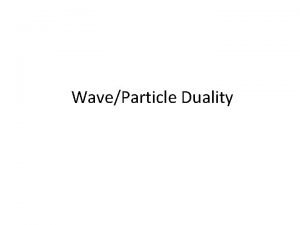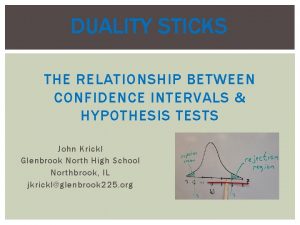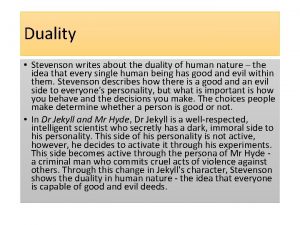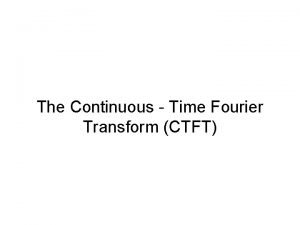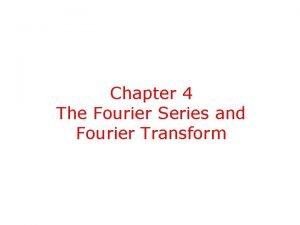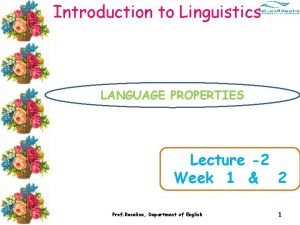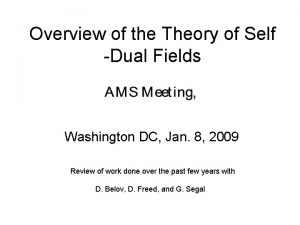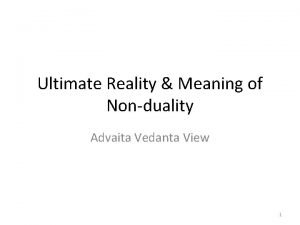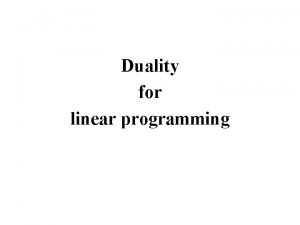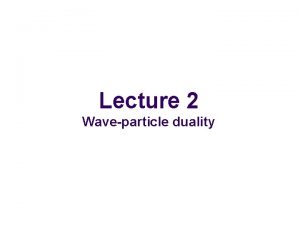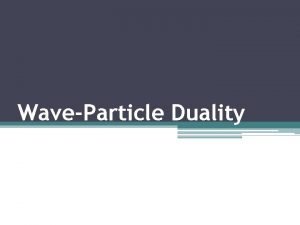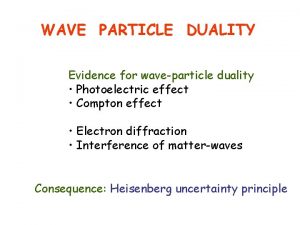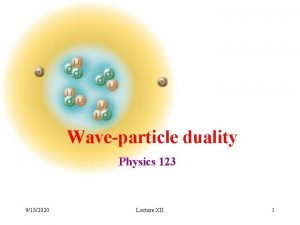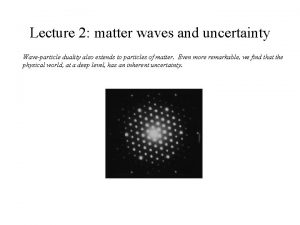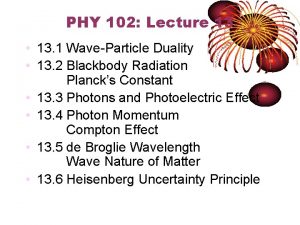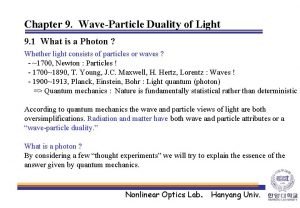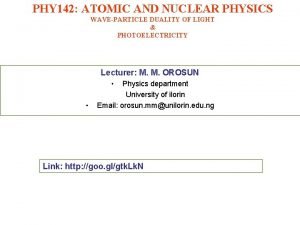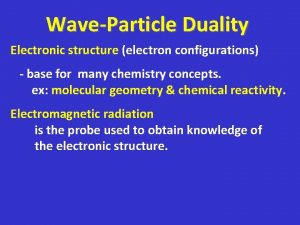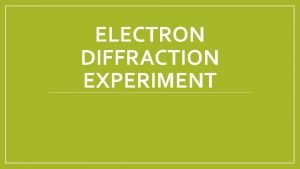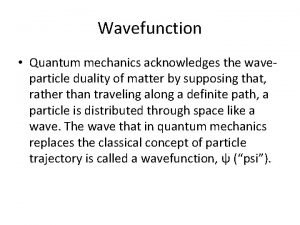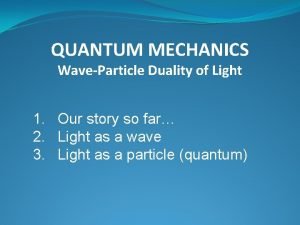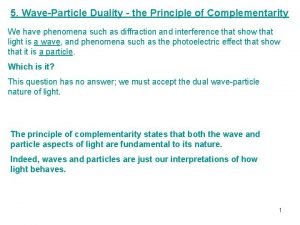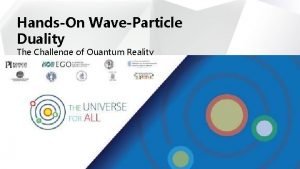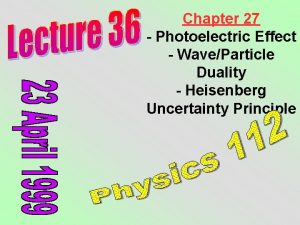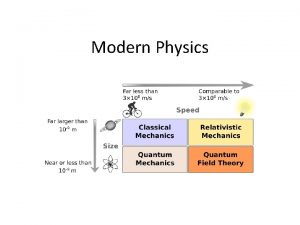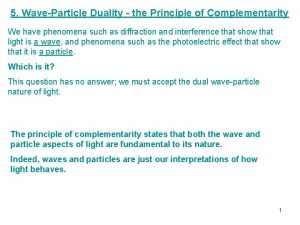Lecture 2 Waveparticle duality c So Hirata Department





















- Slides: 21

Lecture 2 Wave-particle duality (c) So Hirata, Department of Chemistry, University of Illinois at Urbana-Champaign. This material has been developed and made available online by work supported jointly by University of Illinois, the National Science Foundation under Grant CHE-1118616 (CAREER), and the Camille & Henry Dreyfus Foundation, Inc. through the Camille Dreyfus Teacher-Scholar program. Any opinions, findings, and conclusions or recommendations expressed in this material are those of the author(s) and do not necessarily reflect the views of the sponsoring agencies.

Wave-particle duality l l Light has a particle-like characteristics and electrons have wave-like characteristics. The de Broglie relation between wavelength and momentum λ = h / p quantifies these competing characteristics. It is difficult to have a good mental picture of physical entity being a wave and a particle at once. We might just accept this as physical reality.

The particle character of light l l In explaining black body radiation and heat capacity, Planck and Einstein had to assume that the energy of light is limited to 0, hv, 2 hv, 3 hv, …. This suggests that light is a countable, particle-like entity. We call the particle a photon.

The particle character of light l l l Photoelectric effect: The ejection of electrons from metal surfaces when exposed to ultraviolet radiation. This phenomenon is used in solar cells (not exactly) and photoelectron spectroscopy.

The particle character of light l l No electrons are ejected unless the frequency of radiation is greater than a certain threshold, regardless of intensity. Electrons are ejected immediately for the lowest intensity, if the frequency is greater than the threshold.

The particle character of light l l l How is this incongruous to the conventional, wave-like picture of light (electromagnetic radiation)? We would expect that the greater the intensity, the more energy is given to the metal and an electron is ejected, BUT intensity has no role in deciding whether the ejection occurs. We would expect that the longer we shine light, the more energy will build up over time and an electron is ejected, BUT the ejection happens right away with the lowest intensity if the frequency is right.

The particle character of light l The kinetic energy of ejected electrons increases linearly with the frequency but independent of the intensity.

The particle character of light l l All of these can be nicely explained once we accept the particle-like characteristics of light. One particle of light (photon) knocks one electron out of the metal. Electrons are tied to the metal and escaping from the grip of the metal needs some energy (work function Φ). A photon has an energy of hv (proportional to frequency but independent of intensity).

The particle character of light l l l If the energy of a photon hv is smaller than the work function, an electron cannot escape the metal surface. If it is greater, a single photon is consumed by a single electron, which is then ejected (immediately and at minimum intensity). The extra energy hv – Φ becomes electron’s kinetic energy.

The particle character of light l Compton scattering Authur Compton discovered that an electron is scattered by light (because a photon is a particle with a momentum).

The particle character of light l Macroscopic effects of particle character of light: l l Our skin does not get burned or tanned by infrared or visible light no matter how long we are exposed to the light (as in a car whose glass windows shield UV). A modern photomultiplier can easily count photons all the way down to one photon. See the image of Super-Kamiokande’s photomultiplier arrays at http: //www. sinet. ad. jp/case-examples/neutrino-research

The wave character of particles l l Light has both wave-like and particle-like characters. Do particles such as electrons also have wave-like character? The answer is YES.

The wave character of particles l The Davisson-Germer experiment l l Davisson and Germer showed that electrons exhibit diffraction, a phenomenon characteristic to waves. Electron diffraction and neutron diffraction are widely used experimental techniques today, complementing X-ray diffraction.

The wave character of particles l l A thin film of oil shows a rainbow pattern. This is caused by the constructive and destructive interference of light reflected by the upper and lower surfaces of the film. An electron can also be scattered by the different layers of a crystal lattice and interfere constructively or destructively, giving rise to alternating intensity patterns.

Diffraction

The wave character of particles l l l Light is a wave and a particle; an electron is a particle and a wave. Is everything wave and a particle? The answer is YES The wave-like and particle-like characteristics of a physical entity are inversely proportional to each other as described by the de Broglie relationship.

The de Broglie relation Planck’s constant Wavelength (wave-like) Momentum (particle-like) The larger the wavelength, the more wavelike characteristics; the larger the momentum, the more particle-like characteristics. Louis de Broglie

The de Broglie relation

The de Broglie relation l The de Broglie relation also defines the momentum of a photon (whose rest mass is zero and the classical mv formula does not apply).

Homework Challenge #1 Planck’s constant Wavelength (wave-like) Momentum (particle-like) Einstein’s mass-energy formula from special theory of relativity

Summary l l l A physical entity has both wave-like (wavelengths, interference, diffraction, etc. ) and particle-like (momentum, collision, countable, etc. ) characteristics. Wave-like and particle-like characteristics are inversely proportional to each other and are related by de Broglie equation λ = h / p. An electron has a wavelength; a photon has a momentum.
 Daisuke hirata
Daisuke hirata So hirata
So hirata Christopher hirata
Christopher hirata Edson shiguemi hirata
Edson shiguemi hirata Christopher hirata
Christopher hirata Schrodinger wave equation
Schrodinger wave equation 01:640:244 lecture notes - lecture 15: plat, idah, farad
01:640:244 lecture notes - lecture 15: plat, idah, farad What is a particle
What is a particle Duality of fourier transform
Duality of fourier transform Wave particle duality questions
Wave particle duality questions Duality of confidence interval and hypothesis test
Duality of confidence interval and hypothesis test The duality of man quote
The duality of man quote Ctfs fourier
Ctfs fourier Duality in frankenstein
Duality in frankenstein Fourier series formulas
Fourier series formulas Arbitrariness
Arbitrariness Self-duality
Self-duality What is duality in accounting
What is duality in accounting Three levels of reality in advaita vedanta
Three levels of reality in advaita vedanta Customer supplier duality
Customer supplier duality Dual problem in lpp
Dual problem in lpp Konsep dualitas
Konsep dualitas


